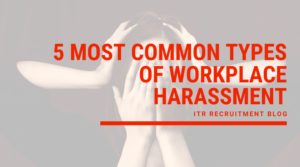5 most common types of workplace harassment

Workplace harassment continues to grow, however, it shouldn’t be just HR’s duty to spot. Every person in the office should familiarise themselves with what it looks like. It can lead victims to have irreversible psychological and physical harm.
If you’re well-informed you can spot the signs and therefore be able to help yourself or a victim with the experiences. In addition, you should learn how to take the necessary step on how to file the complaint.
Here are the five most common types of harassment found in the workplace and what you can do to stop it.
Discriminatory Harassment
This would be any negative behaviour taken towards someone based on their race, religious beliefs, or gender. Here is a full list of what accounts for discriminatory harassment.
Power Harassment
This is a power imbalance between the harasser and the harassed. The harasser will use their professional ranking to bully the victim. For instance, belittling, intimidating and making them do unwanted acts.
Physical Harassment
This can involve violence, physical attacks, or threats. In severe cases, it can be classified as a form of assault.
Cyberbullying
Digital interface has become such a big part of the workplace. It’s not surprising that not every message we receive is a friendly one. Instant messaging applications offer convenience however, can also create a space for easy targeting. The definition of cyberbullying is; the use of electronic communication to bully a person, typically by sending messages of an intimidating or threatening nature.
Psychological Harassment
This type of harassment can cause real damage to a person’s mental health. It can make them feel insecure, put down, or belittled. Psychological suffering can lead to long term damage. In addition, can affect work, family and social life.
How to stop workplace harassment
- Focus On Policy
Ensure that the company you work for have a strict code and policy in place. Do the policies explain what the procedures are about workplace harassment? Policies in place that are enforced and accurate will help staff abide and therefore prevent any misconduct.
- Show Support
Showing support for the victim is crucial. A lot of victims feel embarrassed or scared to talk about the harassment after it has happened. Your company should provide a platform where victims can safely discuss their experience and also provide the support they need.
- Train Your Staff
It is good for companies to provide the training to staff about workplace harassment and how to deal with it. However, if your company doesn’t, take it upon yourself to learn and familiarise yourself with it. In addition learn how to report it the correct way and through the right channels. Through all this be sure to keep the victims experience private and safe.
Check out our latest blog on Job-Hopping. Here are 4 steps to break it.
Follow us on LinkedIn for more career opportunities and recruitment tips!
Follow us for more updates


